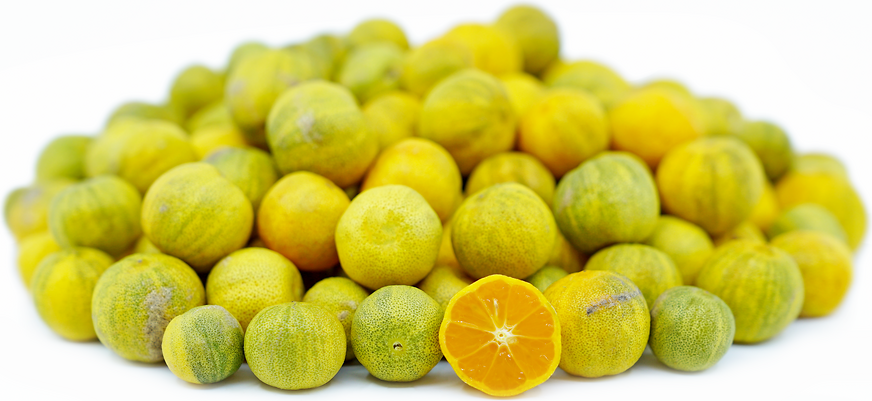


Variegated Calamondin Limes
Estimated Inventory, 10 lbs : 0
Description/Taste
Variegated Calamondin limes are small in size, averaging 2-5 centimeters in diameter, and are globular to oblate in shape. The thin skin is smooth with many small, prominent oil glands, and is striped with green and yellow hues that eventually matures to orange. The leaves are also marbled with green and yellow hues. The orange flesh is juicy, soft, speckled with many small, inedible seeds, and is divided into 7-9 segments by thin, pale orange membranes. Variegated Calamondin limes, even when fully ripe, are extremely tart, sour, and acidic.
Seasons/Availability
Variegated Calamondin limes are available year-round, with a peak season in the winter.
Current Facts
Variegated Calamondin limes are a small, tart fruit that is a mutation of the common Calamondin lime that is a cross between a sour, loose-skinned mandarin and a kumquat, technically classifying it an orangequat. Also known as Peter's lime, Variegated Calamondin limes are used for their acidic juice and the trees are also popular ornamental plants for small gardens and containers.
Nutritional Value
Variegated Calamondin limes are an excellent source of vitamin C and are a good source of potassium, vitamin A, fiber, and calcium.
Applications
Variegated Calamondin limes are best suited for fresh applications as their acidic juice is usually used to flavor foods in south-east Asian cuisine, just as lemons or limes are used in the rest of the world. The juice can be added to appetizers, main dishes, soups, noodles, stir-fries, meats, and cooked vegetables for added flavor, and it can also be added to pies, cakes, and gelatins. The pure juice is often pasteurized and bottled as a beverage or concentrate. The whole fruits may be preserved in jellies, jams, or marmalades and used in sauces and custards as an exotic lemon curd alternative. Variegated Calamondin limes pair well with poultry, fish, beef, and pork, shrimp, rice, noodles, carrots, snap peas, celery, cabbage, bell peppers, garlic, Thai basil, lemongrass, mint, and pineapple. The limes can be stored at room temperature for up to one week and in the refrigerator for up to several weeks.
Ethnic/Cultural Info
In the Philippines, Variegated Calamondin limes are used for more than just culinary dishes. The limes are incorporated into hair conditioner, used for bleaching freckles from skin and stains from fabric, and used as a deodorant, an acne treatment, and a remedy for coughs.
Geography/History
Variegated Calamondin limes are a natural hybrid native to China and were spread to the Philippines and Indonesia in ancient times via immigrants and explorers. The fruit then made its way to the United States in 1900, and today Variegated Calamondin limes are cultivated throughout eastern Asia for its juice in Indonesia, Malaysia, Thailand, and the Philippines. The limes can also be found as ornamental plants throughout India, the West Indies, Central America, the Bahamas, and in Florida, California, and Hawaii of the United States.




